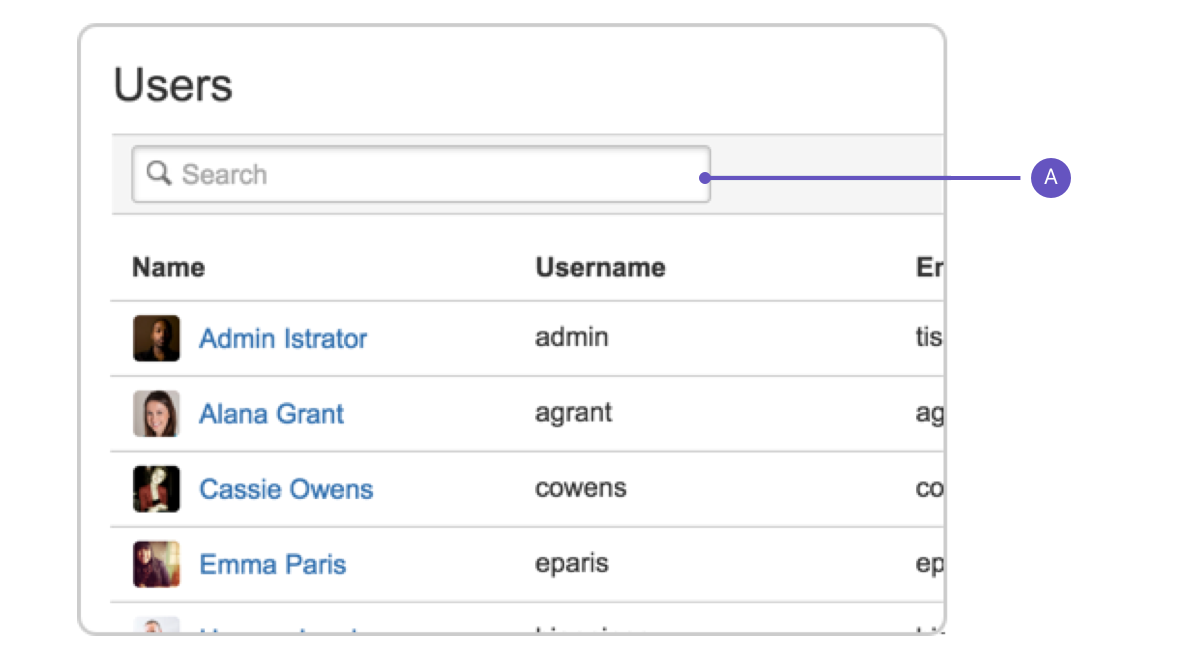Users and groups
Bitbucket Server comes with an internal user directory already built-in that is enabled by default at installation. When you create the first administrator during the setup procedure, that administrator's username and other details are stored in the internal directory.
Bitbucket Server Admins and Sys Admins can manage users and groups in Bitbucket Server as described on this page. You can also set up Bitbucket Server to use external user directories.
Note that:
- Even after users have been added to the Bitbucket Server user directory, they will not be able to log in to Bitbucket Server until they have been given global access permissions.
- Permissions can also be applied separately at the level of projects, repositories and branches.
On this page
Related pages:
Find out how easy, scalable and effective it can be with Crowd!
See centralized user management.
Creating a user
To create a user:
- In the administration area, click Users (under 'Accounts') and then Create user (on the 'Users' screen).
- Complete the form. You can either set the user's password now, or have Bitbucket Server email the user with a link that they can use to set the password themselves:
- Once you've created the user, click Change permissions to set up their access permissions. Note that a user doesn't have access to Bitbucket Server until global access permissions have been set.
- Set up user permissions
See Global permissions for more information.
Creating a group
To create a group, from the administration area:
- Click Groups (under 'Accounts') and then Create group.
- Enter the name for the new group, and click Create group (again):
- Now you can add users to your new group (see the next section).
Adding users to groups
You can add users to groups in two ways:
- add a particular user to multiple groups, from the user's account page in the admin area.
- add multiple users to a particular group, from the group's page.
From the user account page
To add a user to a group from the user's account page,
- Click Users in the Administration section, and then use the filter to find the user:
- User search: Filter users by name or email as you type.
- User search: Filter users by name or email as you type.
- On the account page for the user, use the filter to find a group to which you want to add the user.
- Click Add for each group in turn.
From the group page
To add a user to a group from the group's page,
- Click Groups (under "Accounts') in the administration area, and use the filter to find the group:
- On the page for the group, use the filter to find a user to add to the group.
- Click Add for each user you select, to make them a member of the group.
Changing usernames
You can change the username for a user account that is hosted in Bitbucket Server's internal user directory.
To change a user's username:
- Go to Users in the Administration section, use the filter to find the user.
- On the account page for the user, click Rename.
Deleting users and groups
You can delete a user or group from Bitbucket Server's internal user directory, or the external directory from which Bitbucket Server sources users, such as an LDAP, Crowd or JIRA Software.
When a user or group is deleted from such a directory, Bitbucket Server checks to see if that user still exists in another directory:
- If the user or group does exist in another directory, Bitbucket Server assumes the administrator intended to migrate the user or group between directories and we leave their data intact.
- If the user or group does not exist in another directory, Bitbucket Server assumes the intent was to permanently delete them, and we delete the users permissions, SSH keys and 'rememberme' tokens.
When deleting users
In the case of users from an external directory (e.g. JIRA or LDAP) and internal users (from the internal directory), users or groups are preserved for seven (7) days.
This includes:
- SSH keys
- GPG Keys
- Access tokens
- All user related data stored by apps.
Notes
- If an entire directory is deleted, Bitbucket Server will preserve users and groups for seven days before deleting.
- Content which might be of historical interest (comments, pull requests, etc.) is not deleted when a user or group is. Only authentication, authorization and data which serves no purpose to a user who can no longer log in is removed.
- In some situations, reordering the directories will change the directory that the current user comes from, if a user with the same username happens to exist in both. This behavior can be used in some cases to create a copy of the existing configuration, move it to the top, then remove the old one. Note, however, that duplicate usernames are not a supported configuration.
- You can enable or disable a directory at any time. If you disable a directory, your configuration details will remain but Bitbucket Server will not recognize the users and groups in that directory.
Limitations
- You cannot edit, disable or delete the directory that your own user account belongs to. This prevents administrators from locking themselves out of Bitbucket Server, and applies to internal as well as external directories.
- You cannot remove the internal directory. This limitation aligns with the recommendation that you always keep an administrator or sysadmin account active in the Bitbucket Server internal directory, so that you can troubleshoot problems with your user directories.
- You have to disable a directory before you can remove it. Removing a directory will remove the details from the database.


